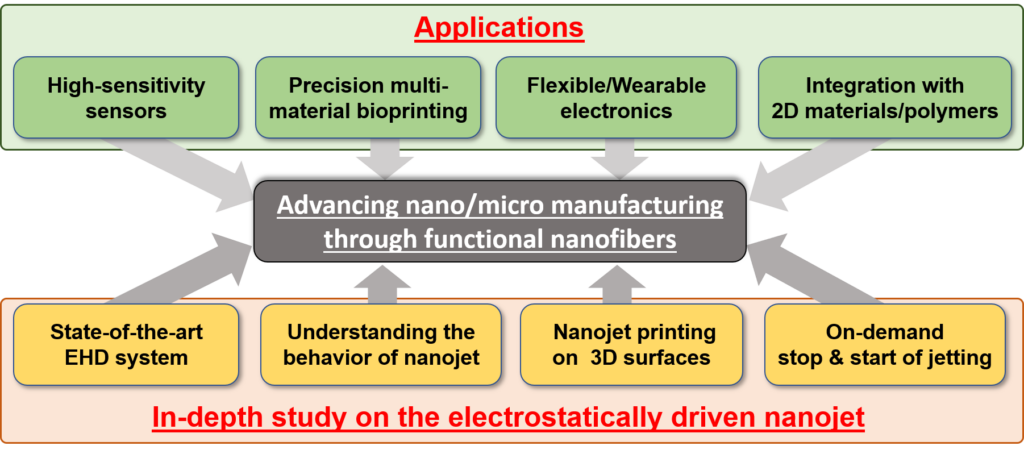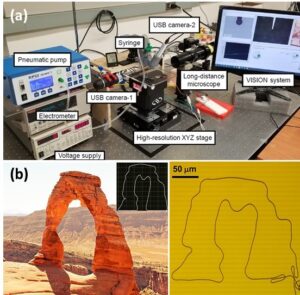Our group explores the synthesis of 2D materials, creating novel hetero-structure and fabrication of flexible/wearable devices. We develop micro/nanoscale tools to explore material/mechanical properties
1.Controlled nanofiber patterning on 2D surfaces (Dongwoon Shin)
The objective of this project is to explore the lowest boundary of electro-hydro-dynamic (EHD) process for precise control of jet speed down below 1mm/s. We have achieved the lowest jet speed (vjet~500mm/s) reported to date using electrospinning process through droplet-jet mode electrospinning. This was possible with the state-of-the-art EHD system I established in my laboratory. In this study, we explored the effect of jet travel distance (JTD), applied voltage, electric field, and the size of the liquid droplet on the jet speed. The result was published in two journal articles and two conference papers. One of the journal articles was featured as a significant breakthrough in electrospinning society in Advances In Engineering (AIE), a non-profit research news publisher. The conference paper on this topic won one of the best poster awards in the largest international electrospinning conference, Electrospin 2019 in Shanghai, China.
2. Direct microscale patterning of nanofibers on 3D surfaces (Dongwoon Shin)
The objective of this project is to study enable electrostatically driven self-aligning nanojets for enabling direct deposition of nanofibers on 2D/3D surfaces with microscale patterning resolution. This research, with integration of 2D materials and other functional polymers, will significantly impact various technologies such as flexible electronics, wearable electronics, and high precision bioprinting. We have significantly expanded the scope of the project from 2D to 3D, by enabling self-aligning nanojet (SA-N). The microscale SA-N, formed on the surface of liquid droplet, is driven by electrostatic shear stress not by the volumetric flow and gravity, thereby the SA-N is automatically aligned along the maximum electric field regardless of the geometry of the substrate as shown in Fig. 2. This project resulted in one journal publication (Advanced Materials Technologies, 2020, IF 5.4), one international conference presentation, and one provisional patent through TVC.
3. Understanding the jetting mechanism of nanojet (Dongwoon Shin)
The objective of this project is to study the initiation mechanism of nanojet through the investigation of charge migration at the liquid-air interface. We have reported our new fascinating discoveries on the deposition of nanoscale fibers in near-field electrospinning (NFES) via sub-microscale polymer jets from an electrostatic micro-cone. By manipulating air-to-polymer ink interface, the surface charge was migrated to a thin, long meniscus of the polymer liquid, and electrostatic micro-cone was formed by breaking the balance between bulk and surface current, followed by ejection of a sub-microscale polymer jet by the cone-jet transition. This study provides systematic studies for the formation of the electrostatic micro-cone, ejection of sub-microscale polymer jet from the micro-cone, and characterize electrostatics of the polymer jet, which pertains to the jetting mechanism in NFES. We believe our discovery will unveil the new governing electrostatics in state-of-the-art EHD process apart from the conventional electrospinning technology and, thus, facilitate the development of new electrospinning or electrospraying technologies, aiming toward wearable and flexible electronics as well as biomedical applications by leveraging the presented discovery.
4. On-demand initiation and termination of nanojet (Dongwoon Shin)
The expansion of the near-field electrospinning technology has been significantly hampered by the lack of a reliable jet stop/start method. The objective of this project is to study the charge trapping mechanism at the microscale cone to enable controlled initiation and termination of nanojet. We have studied a facile and repetitive method of control over initiation/termination of jetting in NFES by manipulating local surface charges at the air-to-polymer liquid interface. An electric field caused by holding voltage is insufficient to achieve the cone-jet transition but traps electrical charges on the surface of the polymer liquid and forms an electrostatic sharp tip. This sharp tip serves as a driving source for the re-initiation of jetting upon the onset of a jetting voltage. Electrical current and voltage measurement, together with optical/scanning electron microscopic images, are used to analyze the transition between initiation phase and termination phase. Using the method, arrays of isolated patterns of nanofiber are successfully demonstrated on both two and three-dimensional surfaces as shown in Fig 4. The ability to direct-write nanofiber on demand will extend the utilization of NFES to broader applications, including printed electronics, nanofiber-based sensors, optoelectronics, and additive manufacturing processes.
5. Mask-less lithography using birefringent fiber (Jonghyun Kim)
The objective of this project is to study the optical birefringent effect in polyethylene oxide (PEO/PEG) fiber to enable mask-less, fast, affordable and high-precision lithography. Ultimately, we plan to advance this technology for sub-micrometer resolution lithography platform. By implementing the optical birefringence in the near-field electrospinning for the first time, we achieved the 0D to 2D features of lithography and advanced functions using 1D fibers, i.e., straight, curved, and isolated dot and area patterns. We also demonstrated facile pattern multilayering without using dedicated alignment marks. This research describes a previously unknown interfaces of 1D functional fibers, modulating the structure of light, in the research and industrial communities that seek practical and affordable microfabricating solutions. We believe this technology will meet the need by leveraging its direct-writing fiber, versatile and reproducible patterning, wide selection of materials, alignment marks-free optical, scalable high-throughput, and mark-less alignment. The innovative approach that our research address is of interest and relevance to interdisciplinary research fields that are not limited to electronics, such as material science, physics, bioengineering, and microelectromechanical systems.
6.Energy harvesting from piezoelectric fibers using omni-directional mechanical strain (Dongwoon Shin)
The objective of this study is to develop technologies to harvest energy to drive independent deployable and in-water operating sensors and optical devices by leveraging the superior piezoelectric properties of PBLG polymers. By incorporating a melt-electrospinning process that directly melts the polymer without solvent, it will maximize the dipole alignment of the PBLG polymer in longitudinal direction and thus improve the energy harvesting efficiency The fiber-shaped PBLG polymer can be directly patterned on various surfaces including flexible and dielectric substrates, and the energy harvesting effect can be greatly enhanced by increasing the density of the fibers through precise patterning process.
7. Integration with 2D materials – tunable graphene gas sensors using functional fibers (Abiral Regmi)
The objective of this project is to develop a novel method of patterning suspended graphene and used so-obtained suspended channel to demonstrate sensing application as a proof of concept. We successfully fabricated a p-type graphene channel by doping the channel with PEO during patterning. All the fabrication steps i.e. bilayer graphene synthesis, transfer and patterning are scalable processes. Enhancement in sensitivity of the sensor was demonstrated with a reduction in the channel size. Further pushing down the scaling limit, together with the employment of a wide range of functional fibers, is expected to greatly enhance the sensitivity as well as detection limit, expanding its applications to various types of sensors not limited to resistive gas sensors.
8. Single-step in-situ fabrication of polymeric convex lens using EHD printing (Jonghyun Kim)
In this research, we have successfully demonstrated an electric field assisted single-step fabrication of the polymer lens and focal length control. A strong coupling between the physical dimension of the lens and electric field was verified through series of tests and simulation. We have incorporated not only experimental but also simulation tools to extensively characterize the performance of the convex lens. A ray tracing simulation is used to predict the varying focal length and the meniscus effects. Finally, the lenses are practically integrated into a microscope for a teleconverter, fluidic tubing for a magnifier, laser exposing for a concentrator, and LED bulb encapsulating for a light diffuser. The proposed process promises a fabrication of tunable convex lenses by leveraging a number of advantages including low process cost, simplicity, continuity, material flexibility, uniformity, and functionality. The research outcome was published in Advanced Materials Technologies in 2019 as one of the Frontispiece articles.
9. With collaborators in Korea Institute of Science and Technology (KIST) : 3D printed injection molding for batch fabrication of microscale graphene/paraffin spheres (Jonghyun Kim)
In this research, we successfully demonstrated a prototype injection molding system for the batch fabrication of centimeter-scale GP-PCM spheres using 3D printing. It was confirmed that the fused-deposition 3D printing technology provides an affordable printer and materials to create key parts, i.e., mold bases. Simple surface correction using silicon grease removes micro-peaks on the surface that were mirrored from the layered 3D mold base. The fluidic analysis indicated that strong pressures and high temperatures contribute to the stable flow of the solution, which is good for filling the cavity of the mold in a controlled manner. However, the selection of suitable process parameters should take into account the melting point and strength of the PLA mold base. According to the thermal analyses, such as Differential Scanning Calorimetry (DSC) and Laser Flash Analysis (LFA), overall, 5% GP-PCM is found to have the most desirable thermal properties in terms of heat capacity and thermal conductivity. Because of its good thermal properties, it is expected to improve the properties of conventional PCM capsules as thermal storage materials. Micro-injected GP-PCM composite is expected to be incorporated directly into thermal energy management systems, such as solar energy systems and industrial waste heat recovery systems.






